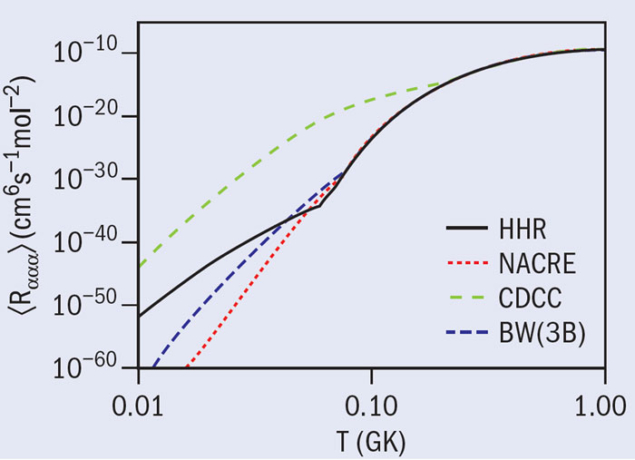
The triple-alpha reaction rate that produces carbon-12 in stars and other energetic astronomical phenomena has been a tricky subject for nuclear theorists for some time. Initially, Fred Hoyle proposed that there should be a 0+ resonance close to the 3α threshold to justify the observed abundances of carbon-12 in stars, a theory that was later confirmed experimentally. However, if there is not enough energy in the stellar environment to reach the narrow resonances involved, then a direct three-body capture becomes the favoured path.
In the Nuclear Astrophysics Compilation of Reaction Rates (NACRE), the direct triple-alpha capture rate has been extrapolated from the two-step resonant capture to temperatures well below 108 K, where the resonant capture dominates (C Angulo et al. 1999). However, this estimation has proved inadequate and nuclear theorists began trying to solve the problem more directly.
Recently, a team at Kyushu University in Japan made use of the continuum-discretized coupled-channel (CDCC) method, which expands the full three-body wave function in terms of the continuum states of the two-body subsystem – in this case beryllium-8 (Ogata et al. 2009). This method is challenging in the case of the triple-alpha reaction problem because the charged-particle reaction occurs at large distances and is dominated by Coulomb interactions. The results reflected these challenges, as the predicted rates showed an increase of 20 orders of magnitude when compared with NACRE, and caused the red-giant phase in low- and intermediate-mass stars to disappear in theoretical models of stellar evolution. Additionally, studies of helium ignition in accreting white dwarfs and accreting neutron stars showed that the CDCC rate is barely consistent with observations of Type Ia supernovae and type I X-ray bursts, respectively.
To skirt some of these difficulties, the nuclear theory group at the National Superconducting Cyclotron Laboratory at Michigan State University combined the Faddeev hyperspherical harmonics and the R-matrix method (HHR) to obtain a full solution to the three-body triple-alpha continuum (Nguyen et al. 2012). The researchers find that the HHR method agrees well with NACRE above 7 × 107 K. However, below that temperature the calculations revealed a pronounced increase of the rate accompanied by a completely different temperature dependence. Though the results do show a strong enhancement at these low energies, it is not as strong as that seen in the CDCC result.
This finding turns out to have crucial repercussions for astrophysics. When the new results are used in stellar evolution simulations within the MESA (Modules for Experiments in Stellar Astrophysics) code, the red-giant phase in the stellar evolution of low- and intermediate-mass stars survives. The team plans to carry out further astrophysical studies to understand the implications of the new rate in explosive scenarios in the near future.
Further reading
C Angulo et al. 1999 Nucl. Phys. A 656 3.
N B Nguyen et al. 2012 Phys. Rev. Lett. 109141101.
K Ogata et al . 2009 Prog. Theor. Phys. 122 1055.





